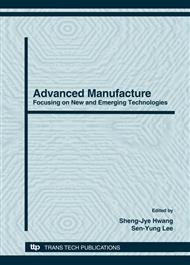p.226
p.235
p.241
p.249
p.255
p.261
p.273
p.281
p.299
Evaluation of Surface Finish Affect on Aerodynamic Coefficients of Wind Tunnel RP Models Production with ABSi Material
Abstract:
Nowadays, rapid prototyping (RP) methods are widely used to produce wind tunnel testing models and thickness of layers is an important parameter that affects the aerodynamic characteristics of model. This paper described the Affects layer thickness models product with rapid prototyping on Aerodynamic Coefficients for Constructed wind tunnel testing models. Three models were evaluated. These models were fabricated from ABSi by a fused deposition method (FDM). The layer thickness was 0.178mm, 0.254mm and 0.33mm. The roughness of surfaces for each model was 25/m, 63/m and 160/m (RZ) that determined by perthometer2. A wing-body-tail configuration was chosen for the actual study. Testing covered the Mach range of Mach 0.3 to Mach 1.2 at an angle-of-attack range of -4° to +16° at zero sideslip. Coefficients of normal force, axial force, pitching moment, and lift over drag are shown at each of these Mach numbers. Results from this study show that layer thickness does have an effect on the aerodynamic characteristics in general; the data differ between the three models by fewer than 6%. The layer thickness does have more effect on the aerodynamic characteristics when Mach number is decreased and had most effect on the aerodynamic characteristics of axial force and its derivative coefficients.
Info:
Periodical:
Pages:
255-260
Citation:
Online since:
August 2008
Authors:
Price:
Сopyright:
© 2008 Trans Tech Publications Ltd. All Rights Reserved
Share:
Citation:


